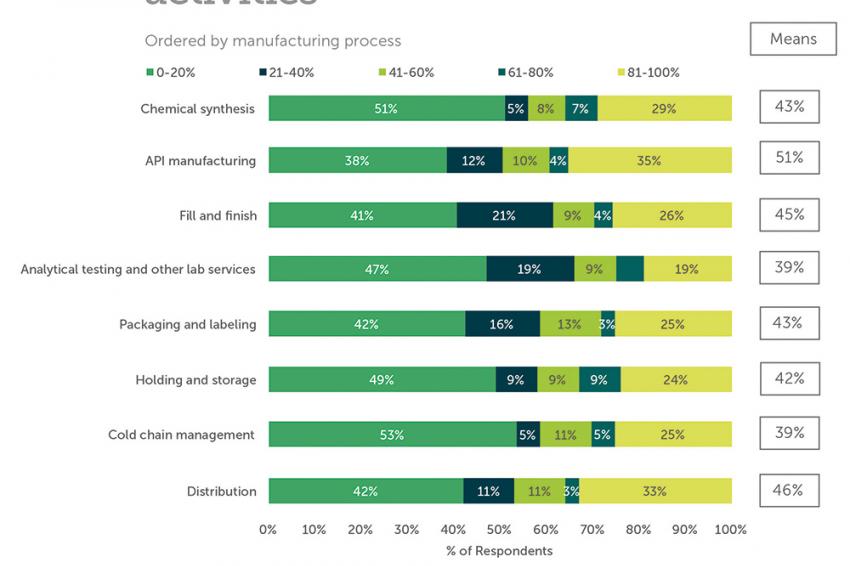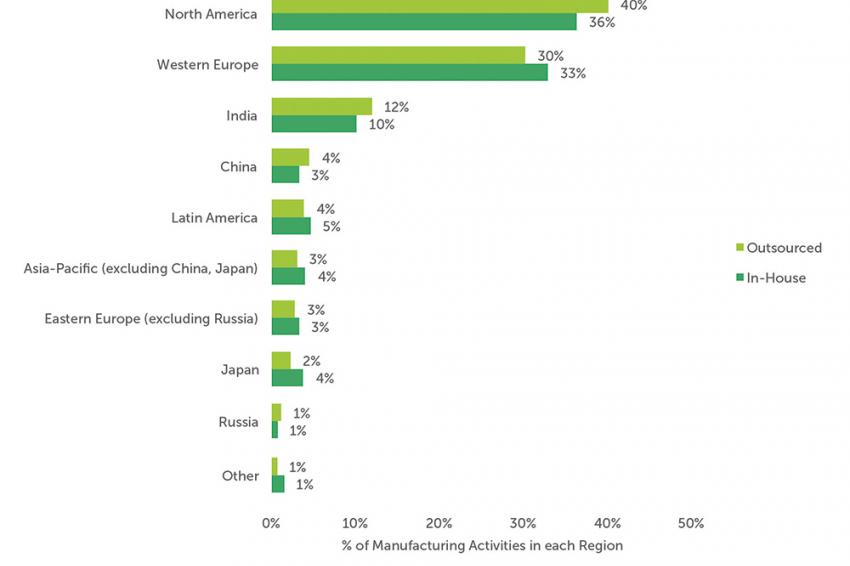Heavy Reliance on Contract Manufacturing
View CMO Strengths through the Eyes of its Customers
The results of ISR’s 2015 Contract Manufacturing Quality Benchmarking study give insight into the outsourcing preferences and practices of 116 buyers of commercial manufacturing services.
The participants reported API manufacturing (51%), fill-finish (45%) and distribution (46%) are outsourced at the greatest frequencies (fig. 1); followed closely by chemical synthesis (43%), packaging & labeling (43%) and holding & storage (41%). An average of 39% of analytical testing / lab services and cold chain management is outsourced.
Outsourcing Practices
The majority of respondents, 50%, work for a drug innovator that manufactures its own products and uses contract manufacturers to augment its internal supply. Over two-thirds of respondents from large biopharmas (R&D $1 billion+) reported using CMOs to augment internally manufactured drug supply. Almost one-third of respondents use CMOs for all of their manufacturing needs; this practice is especially common among smaller companies. A small percentage use CMOs only when they have an emergency need for a product that they are unable to meet.
Heavy reliance on contract manufacturers has fueled the use of preferred providers, with half of respondents reporting the use of a preferred vendor list in 2015; two-thirds anticipate their company will use CMOs from a preferred provider list within three years. Among those with preferred vendor lists, the majority has one to three CMOs on their list. At the same time, a large portion of manufacturing work is still contracted on a one-off basis, but respondents anticipate this practice becoming less common over the next three years. About one-tenth of sponsor-supplier relationships fall into a single-source model. Respondents do not anticipate expanding use of the single-source outsourcing model over the next three years (fig. 2).
Geographic Preferences
When it comes to selecting suppliers, geography plays an important role. The data show a tendency for companies to outsource the greatest proportion of their commercial manufacturing to CMOs within their own geography. That is, companies with a North American headquarters send the highest proportion of outsourced work to CMOs located in the United States and Canada. According to survey participants, 40% of outsourced work is performed in the United States. Western Europe follows with 30%, and trailing in third, 12% of outsourced work is performed in India. A small percentage of outsourced work is conducted in China and South America (4% each); Eastern Europe, Asia-Pacific, Japan and Russia together comprise the remaining 10% (fig. 3).
Supplier Selection Criteria
A CMO’s reliability, regulatory history and capacity are key selection criteria. Sponsors also look for a track record of meeting quality performance metrics and low cost as part of their top five criteria. Not only is it important to convey these attributes in order to win business, excelling across multiple areas is required to maintain business and develop loyalty. The research data show a disconnect between winning business and maintaining it, as respondents reported one favored set of CMOs for perceived leaders, proposal volume and use and a different set of leading CMOs based on performance metrics. This finding strongly reiterates the importance of using real customer feedback, not just industry perception, as part of supplier shortlist due diligence.
Supplier Preferences
When asked what measures are used to judge quality, respondents mentioned FDA compliance, QA/audits and previous experience with the company. Despite its position as a top of mind attribute, quality is particularly hard to judge and define; therefore, meeting expectations for this performance metric is tricky. The full report includes detailed service quality profiles based on 28 performance metrics for 19 contract manufacturers. These ratings evaluations are from recent customers who are either currently working with the CMO or have within the past 18 months, enabling users of the data to make educated contract manufacturing purchase decisions and for suppliers to present their true areas of strength to prospects.







